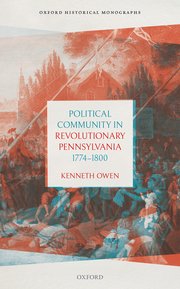 My book, Political Community in Revolutionary Pennsylvania, 1774-1800, will be published in Fall 2018 by Oxford University Press. You can place your orders now! Revising the traditional interpretation of the American Revolution in Pennsylvania as a process of ‘counter-revolution’, I argue that the Pennsylvania Constitution of 1776 should be understood more as a radical manifesto than a frame of government. Its democratic innovations, therefore, possessed political salience long after the constitution’s revision in 1790. These innovations should be understood as at the heart of popular understandings of the Revolution.
My book, Political Community in Revolutionary Pennsylvania, 1774-1800, will be published in Fall 2018 by Oxford University Press. You can place your orders now! Revising the traditional interpretation of the American Revolution in Pennsylvania as a process of ‘counter-revolution’, I argue that the Pennsylvania Constitution of 1776 should be understood more as a radical manifesto than a frame of government. Its democratic innovations, therefore, possessed political salience long after the constitution’s revision in 1790. These innovations should be understood as at the heart of popular understandings of the Revolution.
Essays of mine have appeared in edited volumes. ‘Violence and the Limits of the Political Community in Revolutionary Pennsylvania’ was published in Between Sovereignty and Anarchy (University of Virginia Press, 2015), edited by Patrick Griffin, Robert G. Ingram, Peter S. Onuf, and Brian Schoen. In this essay, I argue that political violence was persistent and pervasive during the American Revolution, because it allowed a way for ordinary citizens to bring attention to their concerns when they felt other representative channels had failed. This violence was often remarkably politically productive – but only when used in conjunction with other mechanisms of political activism that could bring different forms of pressure on elected governments.
‘Legitimacy, Localism, and the First Party System’ appeared in Practicing Democracy: Popular Politics in the United States from the Revolution to the Civil War (University of Virginia Press, 2015), edited by Daniel Peart and Adam I. P. Smith. In this essay, I argue that political success in the 1790s depended fundamentally on engagement with local political activism, expressed through mechanisms of extra-governmental mobilization. Through case studies of three Pennsylvanian elections between 1790 and 1799, I demonstrate how those candidates who most fully embraced local democratic politics experienced the greatest success.